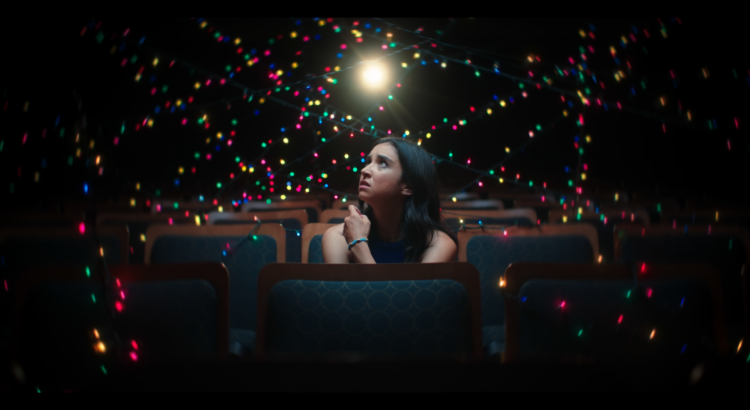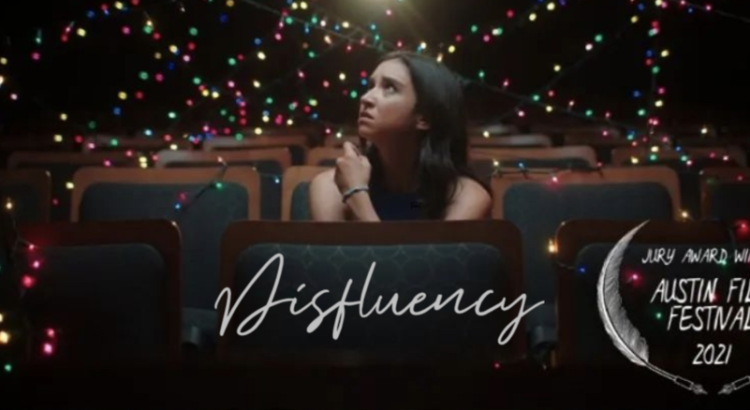What are disfluencies?
My first question about the film “Disfluency” was answered within the first ten minutes: they are “natural interruptions in the smooth flow of speech”—the “uhs,” the “ums,” the “sorries” that fill the gaps in our conversations. It’s a fitting title for a film centered on Jane (Libe Barer), a linguistics student who unexpectedly fails her final class during her senior year of college.
Embarrassed and adrift, Jane retreats to her Michigan hometown for the summer, living with her parents and older sister, Lacey (Ariela Barer), while completing an independent study to earn her final credits. But Jane isn’t the same person her family remembers. Haunted by PTSD after a sexual assault at the start of the semester, her focus unraveled, and failure followed. Her sadness and withdrawal are apparent to her family, but Jane struggles to share her experience. Instead, she eventually opens up to her neighbor, Amber (Chelsea Alden), whom she’s teaching sign language. Through this unexpected connection, the pieces of her trauma slowly surface.
Few movies have moved me to tears quite like “Disfluency.” Maybe it was the achingly familiar depiction of a Michigan summer—its bittersweet nostalgia and quiet moments of reflection. Maybe it was the intimate setting of the Michigan Theater, where the small audience heightened the film’s vulnerability. Or maybe it was Libe Barer’s raw and nuanced performance as Jane—a character so painfully real in her silence, resilience, and search for understanding.
The film’s use of linguistics adds layers to Jane’s story. After a childhood accident left her temporarily unable to speak, she learned sign language, and now offers to teach Amber, whose son is deaf. Language becomes a means of connection but also a symbol of Jane’s struggle to reclaim her voice. In moments of panic or flashbacks, Jane repeatedly says “sorry” or “um”—the very disfluencies referenced in the film’s title. The movie skillfully parallels this linguistic thread with the experience of survivors grappling with whether and how to share their stories. Though the motif at times feels a bit overt, its exploration of the fragility and power of communication is profoundly moving.
Visually, the film portrays PTSD with a raw and creative intensity. Through sudden flashes of string lights, cuts to a theater stage, and fragmented jumps in time, director Anna Baumgarten captures how trauma unpredictably intrudes into Jane’s reality. These moments, disorienting yet poignant, mirror the mental landscape of someone navigating PTSD. In her Director’s Statement, Baumgarten shares that “[i]t was born out of my own experience struggling with imposter syndrome and PTSD in the aftermath of sexual assault during my senior year of college.” This personal connection resonates throughout the film, grounding it in authenticity and empathy.
The heart of the movie lies in its depiction of relationships, particularly the dynamic between Jane and Lacey. Played by real-life siblings Libe and Ariela Barer, their bond feels natural and layered, moving effortlessly between playful banter and profound conversations. The film takes its time to find its footing, but once it does—about twenty minutes in—it becomes an emotional force, drawing the viewer deeper into Jane’s story.
I do wonder how the film resonates with viewers who don’t share my personal connection to Michigan summers. For me, the setting’s familiar warmth heightened the emotional impact, amplifying the quiet moments of reflection and nostalgia. But even without that shared backdrop, the film’s raw portrayal of PTSD and resilience is bound to leave an impression.
Disfluency had only a brief screening at the Michigan Theater but is now available for digital viewing on various platforms. If you’re craving the warmth of summer amid the chill of winter—or simply want to experience a devastatingly honest and beautiful story—I can’t recommend it enough.













